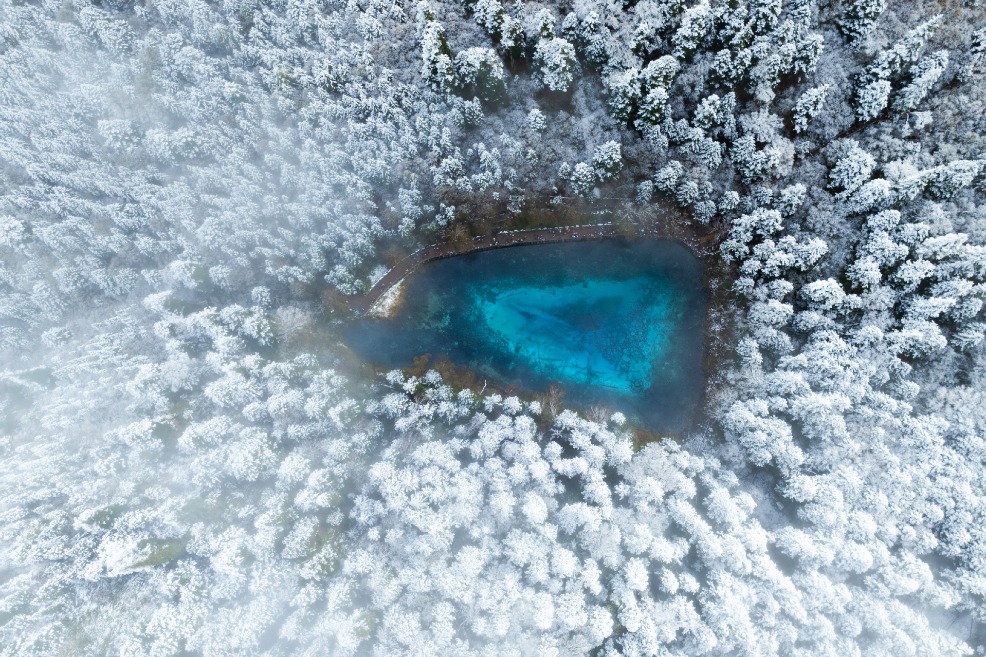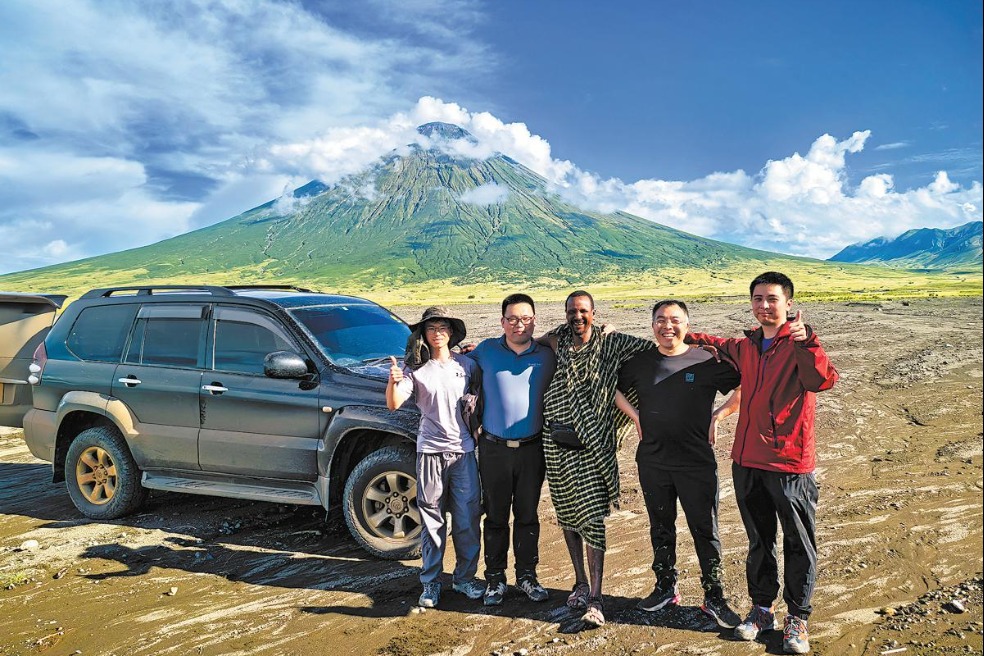Ozone: The weapon to curb COVID-19

Editor's note: "Ozone: A Powerful Weapon to Combat COVID-19 Outbreak" is a paper published by Zhou Muzhi , professor of Tokyo Keizai University and head of the Cloud River Urban Research Institute on Feb. 18, 2020, during the early stage of the COVID-19 outbreak (hereinafter referred to as the "February Zhou Paper"). The "ozone fighting pandemic" series breaks down the paper into three hypotheses, and discusses in detail the complicated relationship between ozone and the ecological equilibrium on the earth as well as the mechanism of ozone inactivating the novel coronavirus. In the second piece of the series, the professor closely examines the three hypotheses and investigates into the logical relationship between them.
1. 'Hand of God' conjecture
SARS raged from the winter of 2002 to the spring of 2003, causing extreme panic in society. However, it suddenly disappeared around May and June in 2003, leaving various speculations behind.
Coincidentally, most of the airborne viruses, such as the influenza virus, erupt in autumn and winter and disappear in spring and summer. It seems that there is an invisible "hand of God" driving away epidemics and saving lives of people.
In regard to the phenomenon, many researchers looked for the correlation between viruses and temperature/humidity. Yet there hasn't been any evidence so far to back up the relationship between virus activity and natural temperature fluctuations. Taking influenza virus as an example, it is generally believed that the virus can maintain its activity for a long time under the condition of low temperature and humidity, and that its activity will be inhibited as the temperature and humidity increase. However, experiments have shown that everyday temperature changes actually do not affect the virus much, although increasing humidity can reduce its activity.
In fact, influenza is typically at its worst between December and March in the northern hemisphere, and between June and September in the southern hemisphere. However, influenza spreads all year round at the equator, the hottest area on the earth, without an obvious peak.
In this regard, based on Hypothesis I that "The low concentration of ozone in nature has always been inhibiting the excessive reproduction of microorganisms such as bacteria, viruses and fungi, and maintaining the ecological balance of the earth," the February Zhou Paper further puts forward the Hypothesis II: "Ozone with oxidation property is the real 'hand of God'."
2. Ozone concentrations vary by latitudes and seasons
Ozone concentrations vary significantly by seasons: low in autumn and winter and high in spring and summer. According to observations of the ozone layer by Japan Meteorological Agency, the total amount of ozone for Sapporo, Tsukuba, Kagoshima, and Naha – Japanese localities from north to south generally reach a peak in February to May, but the peak in the farther north comes earlier and that in the farther south comes later.
Ozone concentrations change from region to region as well. The above observations also show a higher peak concentration in the northern regions and a lower peak concentration in the southern regions. Studies have found that the total amount of ozone in the earth's atmosphere changes significantly with latitude: lowest in equatorial regions and highest in northern regions near latitude 60°. In addition, at mid-latitudes, the total amount of ozone in the northern hemisphere is more than that in the southern hemisphere. In particular, the total amount of ozone in Japan is also high at mid-latitudes.
The stronger the ultraviolet rays, the faster the oxygen molecules break down. The equatorial regions, where the sun shines the most, are the most prone to producing ozone. However, many factors and complex mechanisms act on ozone concentrations. The stronger the ultraviolet rays, the easier it is to either produce ozone or break it down. The rate of ozone resolution is also related to temperature: the higher the temperature, the faster the resolution. These variables interact so that ozone both forms and breaks down easily near the equator. Earth-scale atmospheric circulation is also one of the factors that cannot be ignored, because it can transport the ozone generated locally to other regions.
The largest source of tropospheric ozone is the ozone layer in the stratosphere. The oxygen produced by plants through photosynthesis, the NOx and VOC emitted out of industrial activities, and the destruction of ozone caused by volcanic eruptions also affect the concentration of tropospheric ozone.
To sum up, ozone concentrations, which depend on the magical resolution and polymerization of oxygen molecules and oxygen atoms, show a pattern of low in autumn and winter and high in spring and summer, and also vary by latitudes – high at high latitudes and low at the equator.
The above analysis concludes that ozone, which is low in autumn and winter and high in spring and summer, is the real "hand of God." It is particularly noteworthy that ozone has correlations with temperature and humidity. One correlation is that the higher the temperature is, the faster ozone breaks down; the other is that humidity can boost the sterilization ability of ozone, and the sterilization ability of ozone will decrease sharply in dry state.
When the season changes and the weather turns warmer, the ozone concentration, temperature, and air humidity would rise, and the "hand of God" would begin to dispel epidemics.
The more rigorous rationale of the Hypothesis II should be that assisted by temperature and humidity, the main force – ozone drives away epidemics as its concentration rises with the seasons. Of course, ultraviolet rays, another killer of microbes, also kills outdoor bacteria and viruses as they become stronger in spring and summer.
Why didn't COVID-19 disappear like SARS in the spring and summer of the second year? There are many speculations about the phenomenon. Compared with SARS, COVID-19 had spread around the world before the ozone concentration rises. The phenomenon can also be explained by the fact that the virus that has been continuously evolving and mutating cross-transmits between the northern hemisphere and the southern hemisphere.
3. Low concentrations of ozone can kill novel coronavirus
On the basis of the Hypothesis I and the Hypothesis II, the February Zhou Paper put forward the Hypothesis III – Ozone at as low concentrations as in nature can inactivate the novel coronavirus.
Ozone, though highly effective for sterilization and disinfection, will cause discomfort, or irritate mucous membranes, when it reaches a certain concentration level. Therefore, it is mainly used in the unmanned environment. If the Hypothetical III – if ozone can inactivate COVID-19 without producing discomfort and side effects on the human body, ozone can be applied to curb the novel coronavirus in the human environment, and thus block the transmission of the virus. Its application will be a blessing for countries around the world that restrict travel to reduce the spread of COVID-19.
As early as March 2020, the Japanese government called for avoiding closed spaces, crowds, and close contact to reduce COVID-19 infections. With repeated "emergency declarations," restrictions on dining out, entertainment and even going out have become the norm. The country's pillar industries, such as restaurant, entertainment, and tourism industries, have borne the brunt from the lockdown, not only devastating economy, but also taking a heavy toll on the physical and mental health of people who are eager to return to a normal life.
Ozone concentration is low in cities, and even lower in crowded spaces. Closed spaces, dense crowds and close contact are much likely to lead to COVID-19 transmission. The use of ozone to inactivate COVID-19 is therefore the ultimate solution to the problem. The use of ozone to inactivate viruses has three characteristics.
Full coverage. Ozone created by ozone generators or electrostatic air purifiers can reach every corner of the environment, which can overcome the problem that ultraviolet sterilization can only go straight up and down, leaving some places unsterilized.
High detergency. Oxidizing bacteria and virus is how ozone works, with no poisonous residue. On the contrary, the chemical disinfectant we use now is not only harmful to human body, but also will cause secondary pollution of poisonous residue. During the current epidemic responses, the overuse of disinfectants has been a serious problem that we should pay attention to.
Convenience. Ozone can be produced by simple equipment. The equipment, large or small, can be used for a single room, a large public space, or public transportation modes such as buses, high-speed railways, ships and airplanes.
Yet, can low concentrations of ozone really kill novel coronavirus? The question will be addressed in the third piece of the series.
- Dazzling Liuyang fireworks festival sets night sky aglow
- China commemorates 80th anniversary of Taiwan's restoration
- Tianjin conference highlights mining partnerships
- 52 giant panda fossils found in Asia's longest cave
- Leung Chun-ying: The huge potential between HK and the rest of the GBA has yet to be tapped
- Aerial view of Jiuzhaigou scenic spot after snow





































